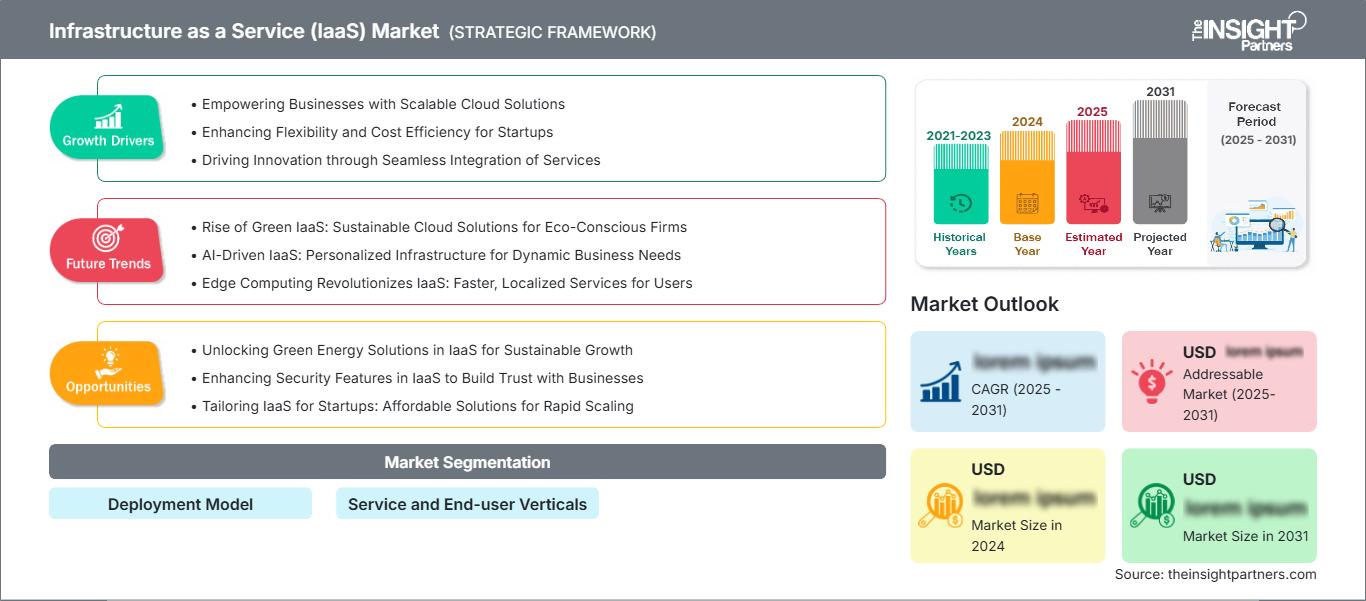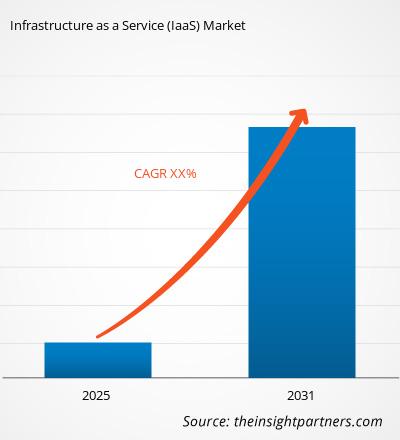Der Markt für Infrastructure as a Service (IaaS) wird bis 2031 voraussichtlich ein Volumen von 772,59 Milliarden US-Dollar erreichen. Für den Zeitraum 2025–2031 wird ein jährliches Wachstum von 20,7 % erwartet.
Der Bericht ist nach Bereitstellungsmodellen kategorisiert und analysiert den Markt zudem nach Service- und Endnutzerbranchen. Für jedes dieser Segmente wird eine umfassende Aufschlüsselung auf globaler, regionaler und Länderebene bereitgestellt. Der Bericht enthält Marktgrößen und Prognosen für alle Segmente, angegeben in US-Dollar. Er liefert außerdem wichtige Statistiken zum aktuellen Marktstatus führender Anbieter sowie Einblicke in vorherrschende Markttrends und neue Chancen.
Der Bericht „IaaS-Markt“ von The Insight Partners beschreibt die aktuelle Marktlage und das zukünftige Wachstum sowie die wichtigsten Treiber, Herausforderungen und Chancen. Dies wird verschiedenen Geschäftspartnern Einblicke bieten, wie beispielsweise:
- Technologieanbieter/Hersteller: Um die sich entwickelnde Marktdynamik zu verstehen und potenzielle Wachstumschancen zu erkennen, damit sie fundierte strategische Entscheidungen treffen können.
- Investoren: Um eine umfassende Trendanalyse hinsichtlich der Marktwachstumsrate, der Finanzprognosen und der Chancen entlang der Wertschöpfungskette durchzuführen.
- Regulierungsbehörden: Um Richtlinien zu regulieren und Aktivitäten auf dem Markt zu überwachen, mit dem Ziel, Missbrauch zu minimieren, das Vertrauen der Investoren zu wahren und die Integrität und Stabilität des Marktes zu gewährleisten.
Marktsegmentierung und Bereitstellungsmodell für Infrastructure as a Service (IaaS)
Dienstleistungs- und Endnutzerbranchen
Sie erhalten kostenlos Anpassungen an jedem Bericht, einschließlich Teilen dieses Berichts oder einer Analyse auf Länderebene, eines Excel-Datenpakets sowie tolle Angebote und Rabatte für Start-ups und Universitäten.
Markt für Infrastructure as a Service (IaaS): Strategische Einblicke

- Holen Sie sich die wichtigsten Markttrends aus diesem Bericht.Dieses KOSTENLOSE Beispiel umfasst Datenanalysen, die von Markttrends bis hin zu Schätzungen und Prognosen reichen.
Wachstumstreiber des Marktes für Infrastructure as a Service (IaaS)
- Skalierbare Cloud-Lösungen für Unternehmen
- Mehr Flexibilität und Kosteneffizienz für Startups
- Innovationen durch nahtlose Serviceintegration
Zukunftstrends des Marktes für Infrastructure as a Service (IaaS)
- Grüne IaaS: Nachhaltige Cloud-Lösungen für umweltbewusste Unternehmen
- KI-gestützte IaaS: Personalisierte Infrastruktur für dynamische Geschäftsanforderungen
- Edge Computing revolutioniert IaaS: Schnellere, lokalisierte Services für Nutzer
Marktchancen für Infrastructure as a Service (IaaS)
- Grüne Energielösungen in IaaS für nachhaltiges Wachstum
- Verbesserte Sicherheitsfunktionen in IaaS für mehr Vertrauen bei Unternehmen
- Individuelle IaaS-Anpassung für Startups: Erschwingliche Lösungen für schnelles Wachstum
Markt für Infrastructure as a Service (IaaS)
Die regionalen Trends und Faktoren, die den Markt für Infrastructure as a Service (IaaS) im gesamten Prognosezeitraum beeinflussen, wurden von den Analysten von The Insight Partners ausführlich erläutert. Dieser Abschnitt behandelt außerdem die Marktsegmente und die geografische Verteilung des Marktes für das Management von Herzrhythmusstörungen in Nordamerika, Europa, Asien-Pazifik, dem Nahen Osten und Afrika sowie Süd- und Mittelamerika.
Umfang des Marktberichts zu Infrastructure as a Service (IaaS)
| Berichtsattribut | Einzelheiten |
|---|---|
| Marktgröße in 2024 | US$ XX Billion |
| Marktgröße nach 2031 | US$ 772.59 Billion |
| Globale CAGR (2025 - 2031) | 20.7% |
| Historische Daten | 2021-2023 |
| Prognosezeitraum | 2025-2031 |
| Abgedeckte Segmente |
By Bereitstellungsmodell |
| Abgedeckte Regionen und Länder | Nordamerika
|
| Marktführer und wichtige Unternehmensprofile |
|
Dichte der Akteure im Markt für Infrastructure as a Service (IaaS): Auswirkungen auf die Geschäftsdynamik
Der Markt für Infrastructure as a Service (IaaS) wächst rasant, angetrieben durch die steigende Nachfrage der Endnutzer. Gründe hierfür sind unter anderem sich wandelnde Verbraucherpräferenzen, technologische Fortschritte und ein wachsendes Bewusstsein für die Vorteile des Produkts. Mit steigender Nachfrage erweitern Unternehmen ihr Angebot, entwickeln innovative Lösungen, um den Kundenbedürfnissen gerecht zu werden, und nutzen neue Trends, was das Marktwachstum zusätzlich beflügelt.

- Holen Sie sich die Markt für Infrastructure as a Service (IaaS) Übersicht der wichtigsten Akteure
Wichtigste Verkaufsargumente
- Umfassende Abdeckung: Der Bericht bietet eine umfassende Analyse der Produkte, Dienstleistungen, Typen und Endnutzer des Infrastructure-as-a-Service-Marktes (IaaS) und vermittelt so ein ganzheitliches Bild.
- Expertenanalyse: Der Bericht basiert auf dem fundierten Wissen von Branchenexperten und Analysten.
- Aktuelle Informationen: Der Bericht gewährleistet Geschäftsrelevanz durch die Berücksichtigung aktueller Informationen und Datentrends.
- Anpassungsmöglichkeiten: Dieser Bericht kann an spezifische Kundenanforderungen angepasst werden und sich optimal in die Geschäftsstrategien integrieren.
Der Forschungsbericht zum Infrastructure-as-a-Service-Markt (IaaS) kann somit maßgeblich dazu beitragen, das Branchenszenario und die Wachstumsaussichten zu entschlüsseln und zu verstehen. Auch wenn einige berechtigte Bedenken bestehen, überwiegen die Vorteile dieses Berichts insgesamt die Nachteile.
- Historische Analyse (2 Jahre), Basisjahr, Prognose (7 Jahre) mit CAGR
- PEST- und SWOT-Analyse
- Marktgröße Wert/Volumen – Global, Regional, Land
- Branchen- und Wettbewerbslandschaft
- Excel-Datensatz
Aktuelle Berichte
Erfahrungsberichte
Grund zum Kauf
- Fundierte Entscheidungsfindung
- Marktdynamik verstehen
- Wettbewerbsanalyse
- Kundeneinblicke
- Marktprognosen
- Risikominimierung
- Strategische Planung
- Investitionsbegründung
- Identifizierung neuer Märkte
- Verbesserung von Marketingstrategien
- Steigerung der Betriebseffizienz
- Anpassung an regulatorische Trends




















 Kostenlose Probe anfordern für - Markt für Infrastructure as a Service (IaaS)
Kostenlose Probe anfordern für - Markt für Infrastructure as a Service (IaaS)